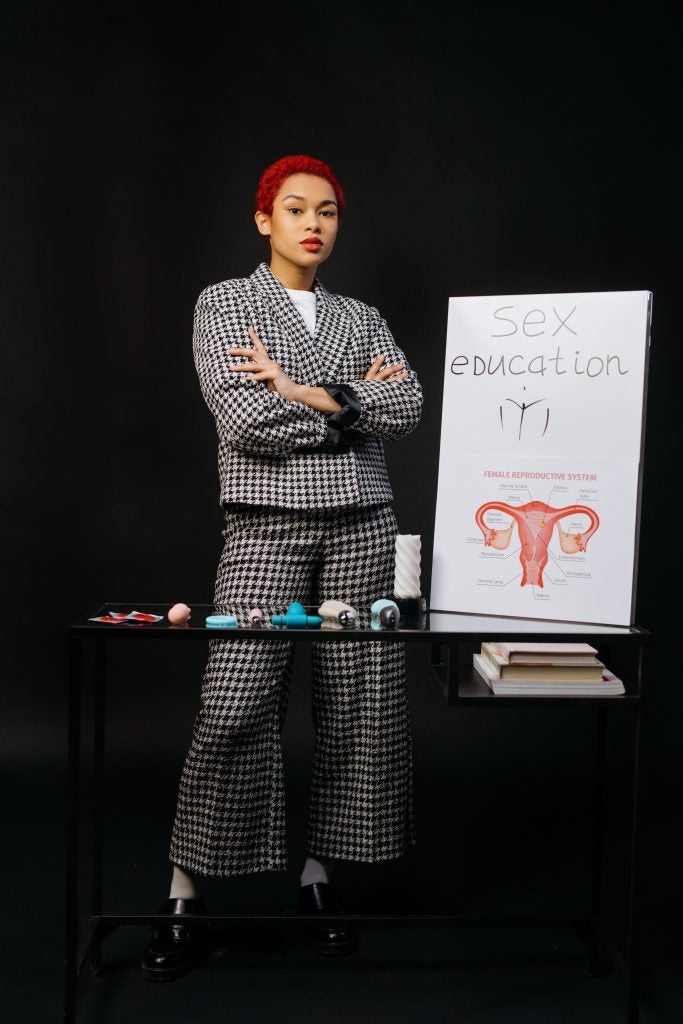Table of Contents
Why Don’t Abstinence-Only Programs Work?
Abstinence-only programs (also known as “abstinence-only-until-marriage” programs) teach students to refrain from sexual activity until they are married. While these programs may have good intentions, they tend to exclude discussion of contraceptive methods, non-heterosexual relationships, gender identity, and abortion. Evidence has shown that young people have sexual experiences regardless of what they have been taught in school. Therefore, these selective lesson plans are causing a number of problems. Without an understanding of birth control methods, students who are only exposed to an abstinence-only education are at a high risk of teen pregnancy and sexually transmitted infections (STIs). Oftentimes, these students resort to learning sex education from other sources and, in turn, may be receiving inaccurate information.1
May Contain False or Misleading Information

The minority staff of the House Government Reform Committee conducted an investigation in 2004 that reviewed 13 of the most common abstinence-only programs taught in schools. The study showed that two of the curricula were accurate, but the 11 others, that are used by 69 organizations in 25 states, provided misinformation, and contained unproven claims. The programs showed subjective conclusions regarding the effectiveness of contraceptives, gender traits, and when the life of a fetus begins. These programs blur the line between science and religion. Some of the misconceptions included in the programs claimed the following:
- A 43 day old fetus is a “thinking person.”
- HIV can be spread through “sweat and tears.”
- 50% of gay male teens test positive for HIV.
- Touching another person’s genitals can result in pregnancy.
- Condoms fail 31% of the time to prevent HIV transmission during heterosexual intercourse.
- Women who have an abortion are more prone to suicide.
- 10% of women who have an abortion become sterile.2
Could Be Seen as Unethical
Health educators providing misinformation, as well as withholding accurate information, can be considered unethical. The education system has a responsibility to provide the youth all the tools they need to make informed decisions on their own sexual health. Students have a basic right to accurate health information. Current federal abstinence laws and guidelines are potentially ethically problematic because they allow for only limited information to be presented to students – including accurate information about contraception and safer sex.
Questionable Results
Despite the backing of many conservative organizations, a congressionally mandated long-term study found that four of the most highly recommended abstinence-only programs should not continue to receive federal funding. The study found that programs had no impact on desired behavioral outcomes. The study concluded that students who received abstinence-only education had their first sexual encounter on average at the same age as the control group. In both the control group and study group, only 23% reported always using a condom when having sex. Additionally, abstinence-only programs did not result in lower rates of sexually transmitted infections (STI) or pregnancies.3 Other recent research shows that abstinence-only strategies may actually decrease contraceptive use among sexually active teens, increasing their risk of unintended pregnancy and STIs.4
Dual Education Can Be Beneficial

Programs that discuss abstinence as well as contraceptive use can be effective. These programs have been shown to help teens delay sexual activity, have fewer sexual partners, and increase contraceptive use when they decide to begin having sex. A major focus of these programs is to engage youth with their schools as well as their communities. Another approach, shown to be effective with younger girls, combines health care, academic assistance, comprehensive sex education, participation in performing arts and individuals sports, and employment assistance.5 The following are aspects of a curriculum that researchers have deemed effective:
- Lasting for more than a few weeks.
- Addressing peer pressure.
- Teaching communication skills.
- Having a narrow focus and a clear message.
- Reflecting the age and culture of the youth in the program.
- Stating that consistent contraception use is important.6
Comprehensive Programs Preferred by the Public
According to a 2003 poll conducted by the Kaiser Family Foundation, National Public Radio, and Harvard University, only 15% of Americans believe that schools should teach exclusively abstinence from sexual intercourse and that the programs should not provide information on condoms and other contraception. A 2007 poll of voters conducted by the National Women’s Law Center and Planned Parenthood Federation of America yielded remarkably similar results, with more than 75% of respondents preferring comprehensive sex education curricula, while only 14% favored an “abstinence-only” approach. Americans also expressed a desire to learn the basics of conception. The following are examples of other information found in the poll:
- 99% of Americans wanted programs to cover other STIs in addition to HIV.
- 98% wanted youth to learn all about HIV and AIDS.
- 94% wanted youth to learn how to get tested for STIs.
- 93% wanted youth to at least be taught about “waiting to have sexual intercourse until married.”
- 83% wanted youth to learn how to properly put on a condom.
- 71% wanted youth to know that “that teens can obtain birth control pills from family planning clinics without permission from a parent.” 6
Comprehensive Education Is Supported
Some of the organizations that support comprehensive sexual education include the American Academy of Pediatrics, American College of Obstetricians and Gynecologists, American Medical Association, American Public Health Association, National Campaign to Prevent Teen Pregnancy, National Education Association, National Medical Association, National School Boards Association, and the Society for Adolescent Medicine, and many more.8 Overall, more than 135 national organizations support comprehensive sexual education, including many of the top research institutions and health professionals in this country.
Ineffective as a Method of Birth Control
Like all methods of birth control, abstinence-only-until-marriage is not 100% effective unless used correctly and consistently. Research suggests that 95% of Americans have participated in premarital sex.9 A recent study was conducted with teens who made a public pledge to abstain until marriage. The study followed up with the youth again six years after they made their pledge and found that over 60% had broken their vow to remain abstinent until marriage. The study also found that while the teens who took virginity pledges begin engaging in vaginal intercourse later than non-pledging teens, those same pledgers were more likely to engage in oral or anal sex than non-pledging teens. Most importantly, these pledgers were less likely to use condoms once they became sexually active. The study found that pledgers were less likely than non-pledgers to use contraception the first time they had sex and also were less likely than other teens to have undergone STI testing and to know their STI status. As a result, the STI rates between pledgers and non-pledgers were statistically similar.10 These studies help conclude that abstinence from sex until marriage is an unrealistic expectation for the youth of America.
More Information Over Less Information

Teens have a need for knowledge regarding sexuality, contraception, STIs, and making sexual decisions. Government sponsored programs have a responsibility to fill the information gap. Some of teen’s knowledge gaps were revealed in a nationwide study by the Kaiser Family Foundation. The survey found that many teens hold misconceptions and harbor unnecessary fear. One example is the belief that contraception can result in infertility or birth defects. Nearly 20 percent of surveyed teens underestimated the effectiveness of the contraceptive patch or ring, and over 25 percent believed that emergency contraception causes abortion. Few teens understood the effectiveness of the male condom in preventing STIs, including HIV. In addition, a ghastly 25 percent of the teens surveyed did not know that oral contraception provides no protection against STIs.11 Health statistics confirm the need for more information and services supplied to adolescents:
- About three out of 10 young women become pregnant at least once before they reach the age of 2017, approximately 750,000 per year.
- 25% of teen females and 18% of teen males did not use contraception the first time they had intercourse.
- The interval between the time an adolescent female starts sexual activity and seeks health care services is approximately a year.
- About 20% of adolescent pregnancies occur within one month of the beginning of sexual activity, and 50% occur within six months.
- An estimated half of all new HIV infections occur in people under age 25.
- Even though they only represent 25 percent of the sexually active population, 15 to 24 year olds acquire nearly one-half of all new STIs.12
There has been a decrease in adolescent pregnancy that can be almost entirely attributed to improved contraceptive use. There has been an 84% decline in teen pregnancy since 1995 and the rates are lower than they have been in 65 years. Even still, the United States leads all developed nations in teenage birth rate.13
Programs Can Discriminate
For gay, lesbian, and bisexual teens, and for those struggling with their sexual orientation or sexual identity, the abstinence-until-marriage approach can be harmful. These programs can often teach youth that homosexuality is deviant, sinful, and immoral. They emulate a heteronormative view of marriage. Abstinence-until-marriage programs rarely, if ever, address the mental health or emotional needs of LGBTQ youth in what is often the most trying time of their lives. Teaching adolescents that homosexuality is sinful could lead to emotional distress in LGBTQ youth who may already feel different from their peers. In addition, abstinence only programs do not provide a forum in which sexually active adolescents can address critical issues. Teens who have already had intercourse still need information on safer sex, the benefits of contraception, legal rights to health care, and ways to access reproductive health services.
Marriage Is Not the Only Option
Abstinence-until-marriage programs depend on the idea that all youth will grow up to get married. There are many other possible family structures, such as cohabitating or remaining single. The number of Americans who are unmarried and single has been growing steadily. A recent poll determined that 41% of all U.S. residents age 18 and older are unmarried. 55 million households are headed by unmarried men or women, accounting for 49% of households nationwide. 12.9 million single parents lived with their children. Nearly 30 million people lived alone (26% of all households), up from 17% in 1970. Forty percent of opposite-sex, unmarried-partner households included children.14
References
- “Implementing Sex Education.” Implementing Sex Education. Planned Parenthood, n.d. Web. 07 Apr. 2015.
- U.S. House of Representatives, Committee on Government Reform. The Content of Federally Funded Abstinence-Only Education Programs, Prepared for Rep. Henry A. Waxman. Washington, DC: Author, 2004.
- Trenholm C et al. Impacts of Four Title V, Section 510, Abstinence Education Programs: Final Report, submitted to the U.S. Dept. of Health & Human Services, Office of the Assistant Secretary for Planning & Evaluation. Princeton, NJ: Mathematica Policy Research, 2007.
- Kirby D. Emerging Answers: Research Findings on Programs to Reduce Teen Pregnancy. Washington, DC: National Campaign to Prevent Teen Pregnancy, 2001.
- Kaiser Family Foundation, National Public Radio, Harvard University. Sex Education in America. Menlo Park, CA: Kaiser, 2004
- Alford S. Science & Success: Programs that Work to Prevent Teen Pregnancy, HIV and Sexually Transmitted Infections. Washington, DC: Advocates for Youth, 2007.
- United States Government Accountability Office. Global Health: Spending Requirement Presents Challenges for Allocating Prevention Funding under the President’s Emergency Plan for AIDS Relief. [GAO-06-395] Washington, DC: Author, 2006.
- National Coalition to Support Sex Education. Coalition Members. NY: SIECUS.
- Finer L. Trends in premarital sex in the United States, 1954-2003. Public Health Reports, 2007; 23: 73.
- Bearman PS, Brückner H. Promising the future: virginity pledges and first intercourse. American Journal of Sociology 2001; 106:859-912.
- National Campaign to Prevent Teen Pregnancy. Analysis of Teen Pregnancy Data. Washington, DC: Author, 2006
- Guttmacher Institute. U.S. Teenage Pregnancy Statistics: National and State Trends and Trends by Race and Ethnicity. New York: Author, 2006
- Hamilton BE et al. Births, preliminary data for 2005. National Vital Statistics Report 2007; 55.
- United States Census Bureau. Special edition, unmarried and single Americans week, Sept. 17-23, 2006. Press Release August 10, 2006.
Last updated: 29 November 2016.
